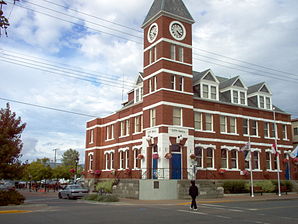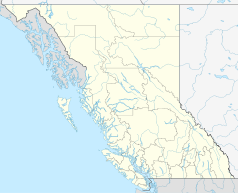Duncan (British Columbia)
| Duncan | ||
|---|---|---|
 Duncan City Hall |
||
| Motto : City of Totem | ||
| Location in British Columbia | ||
|
|
||
| State : |
|
|
| Province : | British Columbia | |
| Regional District : | Cowichan Valley | |
| Coordinates : | 48 ° 47 ′ N , 123 ° 42 ′ W | |
| Height : | 20 m | |
| Area : | 2.07 km² | |
| Residents : | 4944 (as of 2016) | |
| Population density : | 2,388.4 inhabitants / km² | |
| Time zone : | Pacific Time ( UTC − 8 ) | |
| Postal code : | V9L | |
| Mayor : | Phil Kent | |
| Climate diagram | ||||||||||||||||||||||||||||||||||||||||||||||||
|---|---|---|---|---|---|---|---|---|---|---|---|---|---|---|---|---|---|---|---|---|---|---|---|---|---|---|---|---|---|---|---|---|---|---|---|---|---|---|---|---|---|---|---|---|---|---|---|---|
| ||||||||||||||||||||||||||||||||||||||||||||||||
Duncan is a city on Vancouver Island in the Canadian province of British Columbia . It is 50 km from Victoria , the provincial capital, and is the administrative seat of the Cowichan Valley Regional District . The city is called City of Totem (City of Totem Poles ), and thus takes the culture of the First Nations into its self-image.
history
It was not until the 1980s that the city brought its ethnic minorities back into the public eye. This initially brought the First Nations of the region, especially the Cowichan , back into focus. Simon Charlie created some of the largest totem poles in Canada.
The city was named after William Chalmers Duncan, who was born in Sarnia , Ontario in 1836 . He came to Victoria in May 1862 and joined the hundred or so settlers that Governor James Douglas sent to Cowichan Bay . After Duncan heard of gold finds there, he moved to the Fraser River and the Cariboo area . Finally he settled in what is now Duncan and married in 1876. His son Kenneth became the first mayor of the town, which has been a town since 1912.
Duncan's farm was called Alderlea , and that was also the name of the place at first. The Esquimalt and Nanaimo Railway , which opened in August 1886, was not supposed to stop in Alderlea on its maiden voyage. However, since around 2000 people gathered there, the train still stopped unexpectedly.
In the south-west of the village, the construction of the railway resulted in a Chinatown consisting of six Chinese families. They included 30 traders alone, who supplied the loggers, miners and workers in the sawmills and fish factories with their everyday needs. Numerous Chinese also worked as woodcutters, e.g. At the Hillcrest Lumber Company and the Mayo Lumber Company , or as workers in sawmills such as the Island Lumber Company in Somenos . Nothing was left of Chinatown, however, as it was demolished in 1969 to make way for a courthouse. The city almost erased the memory of the Chinese, whose immigration was stopped in 1923. Only outside the city, at Whippletree Junction, have the remains of the Chinese community been collected in recent decades.
There has been a local history museum in town since 1981, the Cowichan Valley Museum .
The granting of local self-government for the community took place on March 4, 1912 ( incorporated as City ).
Demographics
The last official census , the 2016 Census , showed a population of 4,944 inhabitants for the settlement, after the 2011 census still showed a population of 4,986 inhabitants for the municipality. Compared to the last census in 2011, the population increased by a weak 0.2% and developed less strongly than the provincial average, with a population increase of 5.6%. In the census period from 2006 to 2011, the number of inhabitants in the municipality had decreased by 1.1%, while the provincial average increased by 7.0%.
At the 2016 census, the average age of the residents was 50.9 years, well above the provincial average of 42.3 years. The median age of the residents was determined to be 54.4 years. The median age of all residents in the province in 2016 was 43.0 years. For the 2011 census, a median age of 52.3 years was determined for the inhabitants of the municipality, and 41.9 years for the inhabitants of the province. The population in Duncan is aging faster than the provincial average.
education
In 1969, under the name Malaspina University-College, a small college was established, which was promoted to university on April 23, 2008 and is now called Vancouver Island University . Other parts of the VIU are in Nanaimo and Parksville , 100 and 200 km north of Duncan, respectively.
economy
Today the city has a large Indian community, which has become known in the fashion market for the so-called Cowichan Sweaters .
In contrast, the timber industry not only suffers from the depletion of resources, but also from raw wood exports to the USA. Recognizing the importance of this industry, GE (Gerry) Wellburn established the BC Forest Discovery Center .
traffic
Duncan is on the Trans-Canada Highway ( Highway 1 ). This leads in a north-south direction through the urban area. Highway 18 to Lake Cowichan begins in the north of the city .
On the southern outskirts of Duncan is the local airport ( IATA airport code : DUQ, Transport Canada Identifier: CAM3). The airfield only has a very short asphalt runway, 463 meters long.
sons and daughters of the town
- Geoff Courtnall (born 1962), ice hockey player
- Mac DeMarco (born 1990), musician
- Phil Dwyer (* 1965), jazz musician
- Scott McCaig (* 1965), Canadian religious and Roman Catholic military bishop of Canada
Web links
- Duncan ( English, French ) In: The Canadian Encyclopedia .
- Official website (English).
- Duncan on britishcolumbia.com (Engl.)
- Downtown site
- University website
Remarks
- ^ A b Duncan Community Profile. Census 2016. In: Statistics Canada . August 9, 2019, accessed September 5, 2019 .
- ^ From Camp to Community - Where They Came From - China. In: virtualmuseum.ca. Retrieved April 8, 2018 .
- ^ Origin Notes and History. Duncan. In: GeoBC . Retrieved August 10, 2012 .
- ^ Duncan Community Profile. Census 2011. In: Statistics Canada . May 31, 2016, accessed September 5, 2019 .
- ^ Province to Establish Vancouver Island University , archive.org, May 2, 2008.
